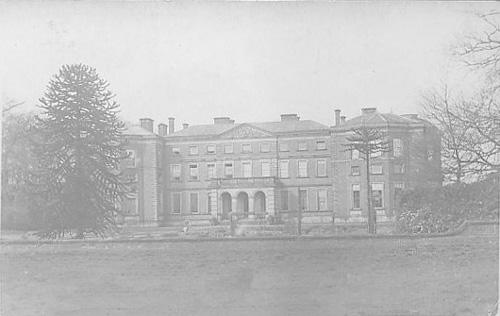Somerford Hall
Cheshire
| Location | Somerford | ||
| Year demolished | 1926 | ||
| Reason | Delapidations due to use during WWI as hospital, and insufficient wealth to repair | ||
| See all images: | Gallery | ||
| << Back to the main list |
Somerford Hall was one of the many large and imposing Georgian houses which used to populate Cheshire but sadly it became a victim of the first wave of country house demolitions between World War I and II.
 The core of the house was built around 1720 by an unknown architect for Peter Shakerley. The Shakerleys had inherited Hulme Hall and 3,000 acres in the mid-15th century and lived there with the estate passing through the family until they decided that a grander seat was needed and moved to Somerford. The house was then extended again sometime in the 18th-century by T.F. Pritchard but was most distinctively enlarged around 1800 by Lawrence Robinson (b.? - d.1797) of Middleton, Lancashire.
The core of the house was built around 1720 by an unknown architect for Peter Shakerley. The Shakerleys had inherited Hulme Hall and 3,000 acres in the mid-15th century and lived there with the estate passing through the family until they decided that a grander seat was needed and moved to Somerford. The house was then extended again sometime in the 18th-century by T.F. Pritchard but was most distinctively enlarged around 1800 by Lawrence Robinson (b.? - d.1797) of Middleton, Lancashire.
Robinson's work included the addition at right angles to the existing 9-bay house of a large rectangular wing with a canted bay on the entrance front. The new front, which faced the park, boasted an elegant, central domed bow which had a distinct 'Wyatt' feel to it - unsurprising considering that Robinson had been clerk of works to James Wyatt whilst he was working at Heaton Hall and trained with James' brother Samuel.
The house was then altered for Sir Charles Watkin Shakerley (b.1833 - d.1898) in 1859-60 by Anthony Salvin, with the addition of a heavy Italianate porch. The parkland was laid out in the 19th century by John Webb (b. c.1754 - d.1828). Sir Walter Geoffrey Shakerley, 3rd Baronet (b. 1859 – d.1943) inherited in 1898. During World War I, the house and estate were initially used as a convalescence hospital for British and Belgian soldiers with Sir Walter, who was also Honorary Colonel of the 7th Cheshire Battalion, in charge. By March 1915, it had been re-designated as an Auxiliary Hospital, to accomodate sudden spikes in demand which were not possible to accomodate within the existing Manchester hospitals. The house was in almost continuous use throughout the war until it closed in 1919, following which, Colonel Sir Walter & Lady Hilda wrote to the local paper in June, highlighting that 1,424 patients had been looked after, and to thank the locals for their support.
The house now reverted to being a family home but the heavy wartime use had taken a toll and the house was now in need of significant repairs and refurbishment. With taxes increasing, the Shakerley family were forced to sell, with the house and estate being auctioned in July 1926. With much of the estate sold to the tenant farmers, the house and a reduced parkland were sold but the new owner baulked at the costs to return it to its former glory and so it was demolished. Much of the parkland has now been turned into farmland but the chapel, icehouse and the large 18th-century stables survive.